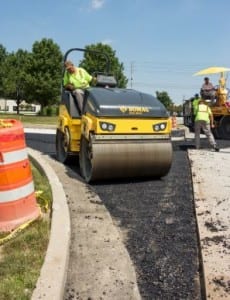Proper compaction of soil, asphalt, and concrete is perhaps the greatest determinant of a project’s lifespan. When performed properly, compaction adds to load-bearing ability and prevents expansion, contraction, and seepage. Improper compaction can cause potholes, poor drainage, cracked drywall, and worse problems. Selecting the proper compaction equipment is the first step toward making a project foundationally sound.
Several considerations bear on choosing the right kind of compaction equipment.
- Vibratory compactors “shake” soil particles to reduce friction and allow them to fall into close proximity to one another.
- Static compactors rely on the machine’s weight to compress soil particles closer together.
 Rammers Achieve Compaction in Tight Spaces
Rammers Achieve Compaction in Tight Spaces
Rammers use gasoline or diesel engines to drive the rammer foot down into the soil, delivering around 10 concentrated, high-velocity punches every second to compact the soil in construction footings or other tight spaces, such as backfilling trenches. Balanced slightly forward, to allow the rammer to bounce and advance slightly with each stroke, rammers are also known as Jumping Jacks.
Jumping Jacks have a smaller foot and are often used to compact backfill in narrow trenches for utility work and applications in clay, silt, and other cohesive soils because the rammer’s shearing action pushes out air and water pockets. They generally are ineffective on granular materials.
 Plates Compact with Maneuverability
Plates Compact with Maneuverability
Commonly used to prepare the ground for paving stones, walkways, and other landscaping applications, vibratory plate compactors combine a compact design with the ability to handle sand, gravel, and other granular substrate. They create frequent vibrations – often up to 10 times faster than rammers – harnessing both pressure and vibration to break particles apart, allowing gravity to pull them into a stable position.
Common plate sizes range from 12 to 24 inches, allowing more surface contact than rollers, and their vibratory action propels the machine along, making it maneuverable. They usually are the best choice when the area to be compacted is small enough that it does not require a large walk-behind or ride-on roller. Larger models can work in reverse as well as forward, adding maneuverability, and allowing operation while stationary.
 Rollers Quickly and Efficiently Compact Large Areas
Rollers Quickly and Efficiently Compact Large Areas
When the project requires a large, flat, surface in granular soil, rollers may be the best option. Rollers come in various sizes and weights. Long stretches of roadway call for heavy hitters – ride-on rollers with single or double drums weighing from one to several tons to compact gravel and asphalt bases. Double-barreled walk-behind models can handle most jobs. They use smooth vibrating drums to quickly and efficiently compact and smooth the substrate for parking lots and concrete warehouse slabs. In rough conditions or when working with highly cohesive soil, rollers with padded feet help shear the soil for more thorough compaction.
When space confinements require smaller footprints and a plate compactor is not feasible, a remote-controlled trench roller could be the best choice. These come equipped with padded, or sheepsfoot. Rollers built to effectively compact the clay and other cohesive soils are often found in utility trenches.
Get the Right Compaction Equipment for Your Next Job
The Pro Group carries many of the most popular plate compactors, rammers, and rollers for every size job. Our experts can walk you through the selection process by helping you find the right compaction equipment fit for your job, whether you are looking to buy or rent.
Request a quote or call us today at (857) 706-2980 to speak with a representative.






